Winning the Fantasy Hockey Waiver Wire
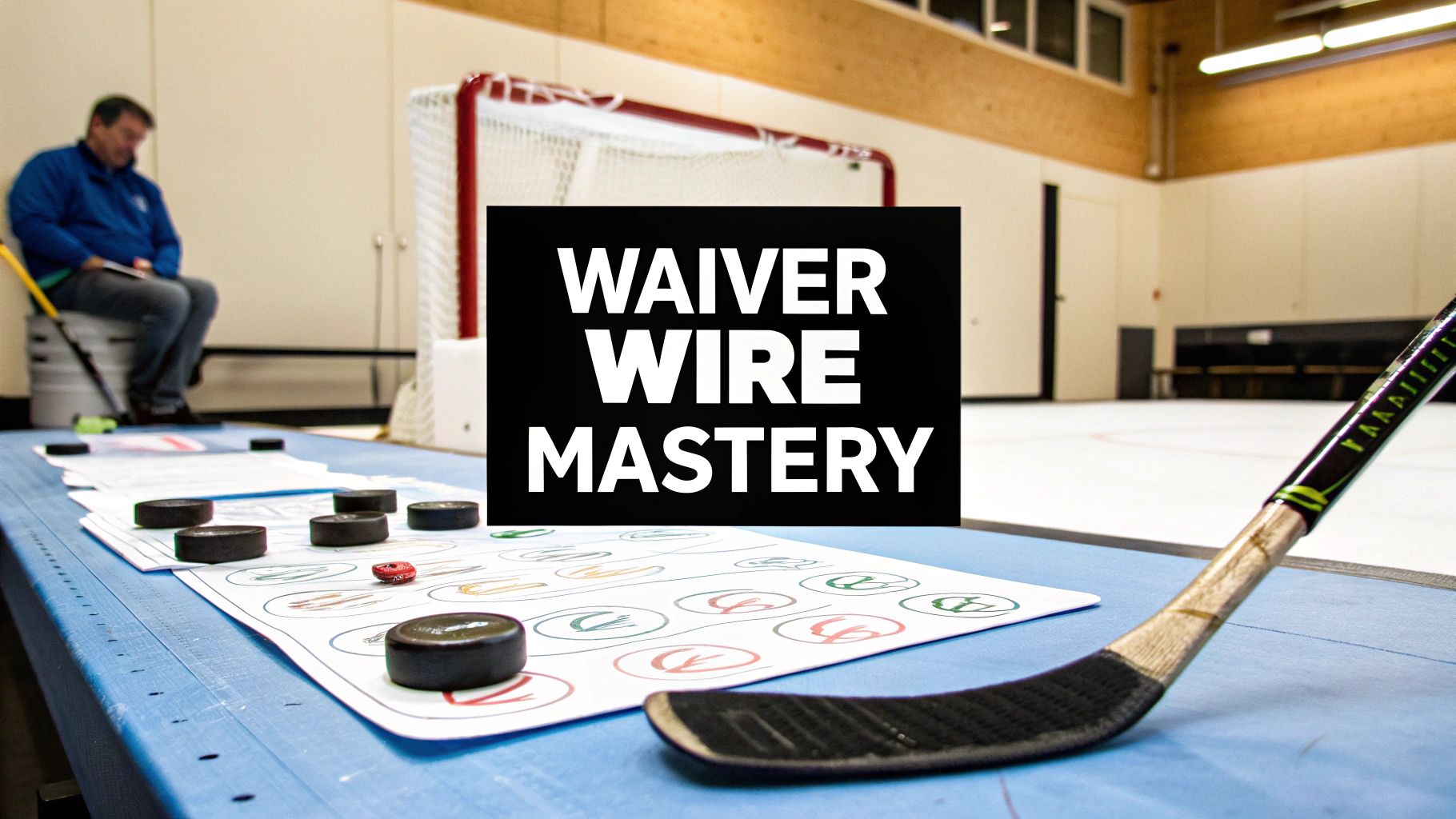
The fantasy hockey waiver wire is your league's lifeline. It's the ultimate in-season tool to patch up your roster, find hidden gems, and gain an edge over your opponents week after week. Mastering how it works isn't just a good idea—it's essential for any manager with championship aspirations.
What Is the Fantasy Hockey Waiver Wire?
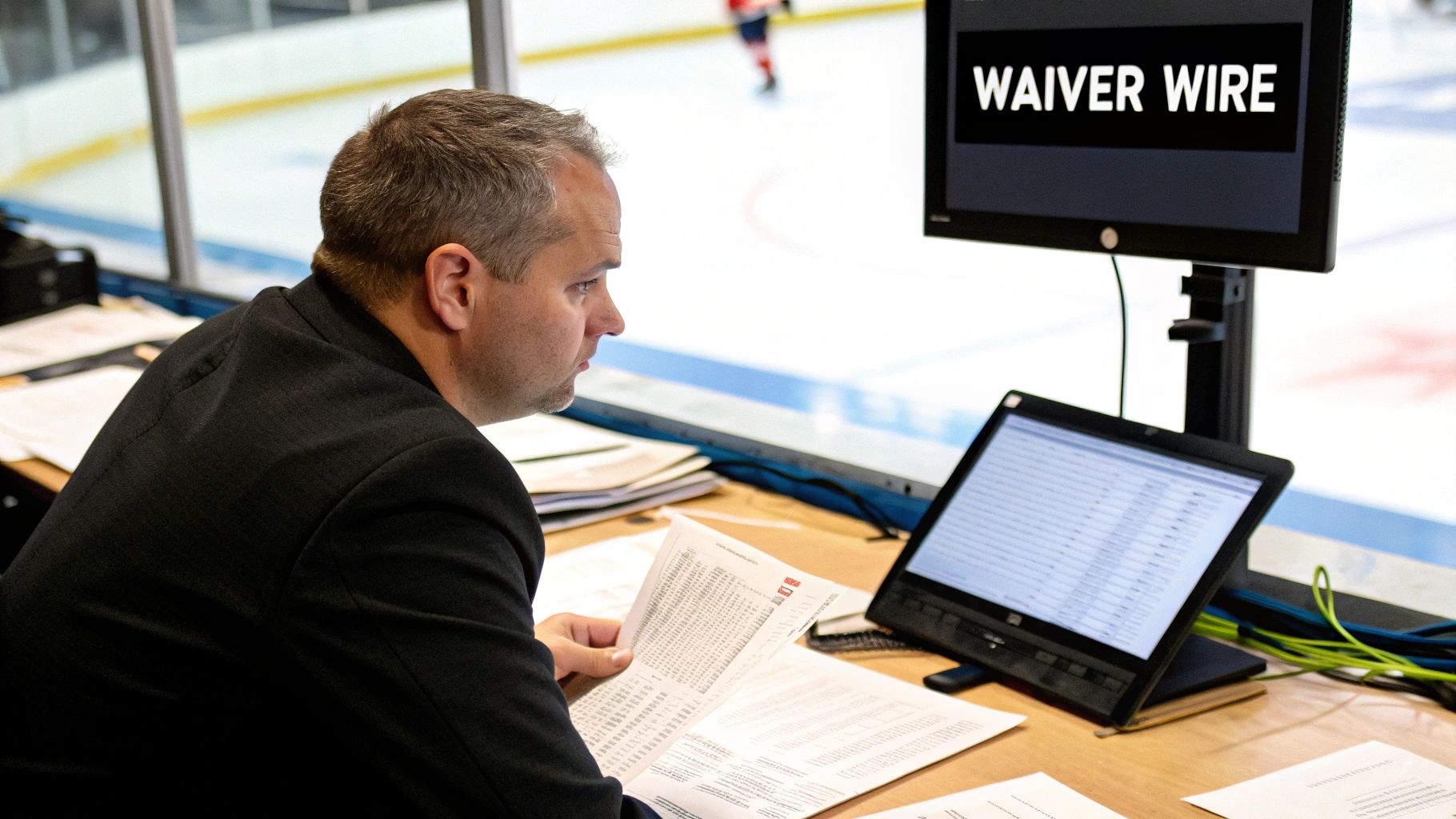
Think of the waiver wire as a controlled auction for recently dropped players. Instead of a chaotic, first-come-first-served free-for-all where the manager who's online 24/7 gets all the good players, the waiver system adds a brief "cooling-off" period.
During this window (usually 24-48 hours), anyone can put in a claim for a dropped player. Once the time is up, the system processes all the claims and awards the player to the manager with the highest waiver priority. It’s a simple mechanism designed to keep things fair and strategic, preventing one manager from hoarding all the talent just because they saw it first.
Waivers vs. Free Agents
It’s crucial to understand the difference between a player on waivers and a standard free agent. They might both be unowned, but how you acquire them is completely different.
- Waiver Claims: These are reserved for players who were just dropped by another team. You have to use your waiver priority (or a bidding budget, in some leagues) to try and get them. Claims are processed at a specific, scheduled time—usually overnight.
- Free Agent Pickups: These are players who have already passed through the waiver period unclaimed. They're available for immediate, unrestricted pickup at any time of day. No priority needed, just an open roster spot.
Let's use a real-world example. Say a frustrated manager drops Jonathan Huberdeau during a cold streak. He won't just appear for anyone to grab. First, he'll hit the waiver wire. If no one places a successful claim on him, then he becomes a free agent, open for anyone to add instantly.
To make it even clearer, here’s a quick breakdown of the key differences:
Waiver Wire vs Free Agents At a Glance
| Aspect | Waiver Wire | Free Agents |
|---|---|---|
| Player Status | Recently dropped by another manager | Unclaimed after the waiver period ends |
| Acquisition | Requires a successful claim using priority or budget | Instant, first-come, first-served pickup |
| Timing | Claims process at a set time (e.g., 3 a.m. ET) | Can be added anytime, 24/7 |
| Competition | All interested managers can place a claim | The fastest manager gets the player |
| Purpose | Ensures fair access to valuable dropped players | Allows for immediate roster adjustments |
At its core, the waiver wire is about one thing: maintaining league balance.
The core purpose of the fantasy hockey waiver wire is to maintain league parity. It ensures that valuable players dropped into the free agent pool are distributed fairly based on a priority system, rather than just speed.
Getting a handle on this system is your first real step toward building a dominant team. A savvy waiver claim can unearth a player who completely turns your season around—much like how scouts look for underrated prospects who could become future stars in our guide to the projected rosters for the 2026 Olympics. Use it wisely, and you can transform an average roster into a true contender.
Navigating Waiver Systems and Priority Rules
Every fantasy hockey league has its own set of rules for the waiver wire, and you absolutely need to know them cold. While the idea is simple—picking up players who aren't on a team—the mechanics can be wildly different. Knowing how your league works is non-negotiable if you want to snag the right players and avoid the frustrating feeling of a rejected claim.
You'll almost always run into one of two systems: the Rolling List or FAAB (Free Agent Acquisition Budget). Each one demands a totally different strategy, so let's break them down.
The Rolling List Priority System
The rolling list is the old-school, traditional waiver format. The easiest way to think of it is like a queue for concert tickets. Your spot in that line is your waiver priority.
At the start of the season, the order is usually the reverse of your draft order. So, if you picked last, congratulations—you start with the #1 waiver priority. The person who drafted first? They're at the back of the line.
Here’s the catch: once you make a successful claim and get your player, you’re sent straight to the very last spot in the queue. Everyone who was behind you shuffles up one spot. This system is all about patience. Burning your top priority on a flavour-of-the-week pickup means you won't have it when a true season-altering player unexpectedly hits the wire.
The FAAB Bidding System
FAAB, which stands for Free Agent Acquisition Budget, is a whole different beast. It’s less like a queue and more like a silent auction. At the start of the year, every manager gets the same chunk of fake money (say, $100 or $1000) to spend on players for the entire season.
When you want a player, you place a blind bid—meaning you have no idea what anyone else is bidding. When waivers process, the player goes to the highest bidder. This system rewards smart budgeting and knowing how to value players. Is that hot rookie worth $15 of your budget, or should you save it for a bigger need later? It's a strategic long game, especially as you plan for the ups and downs of a full year, like those we cover in our 2025-26 NHL season preview.
This image below shows the basic claim process, which applies no matter which system you're in.
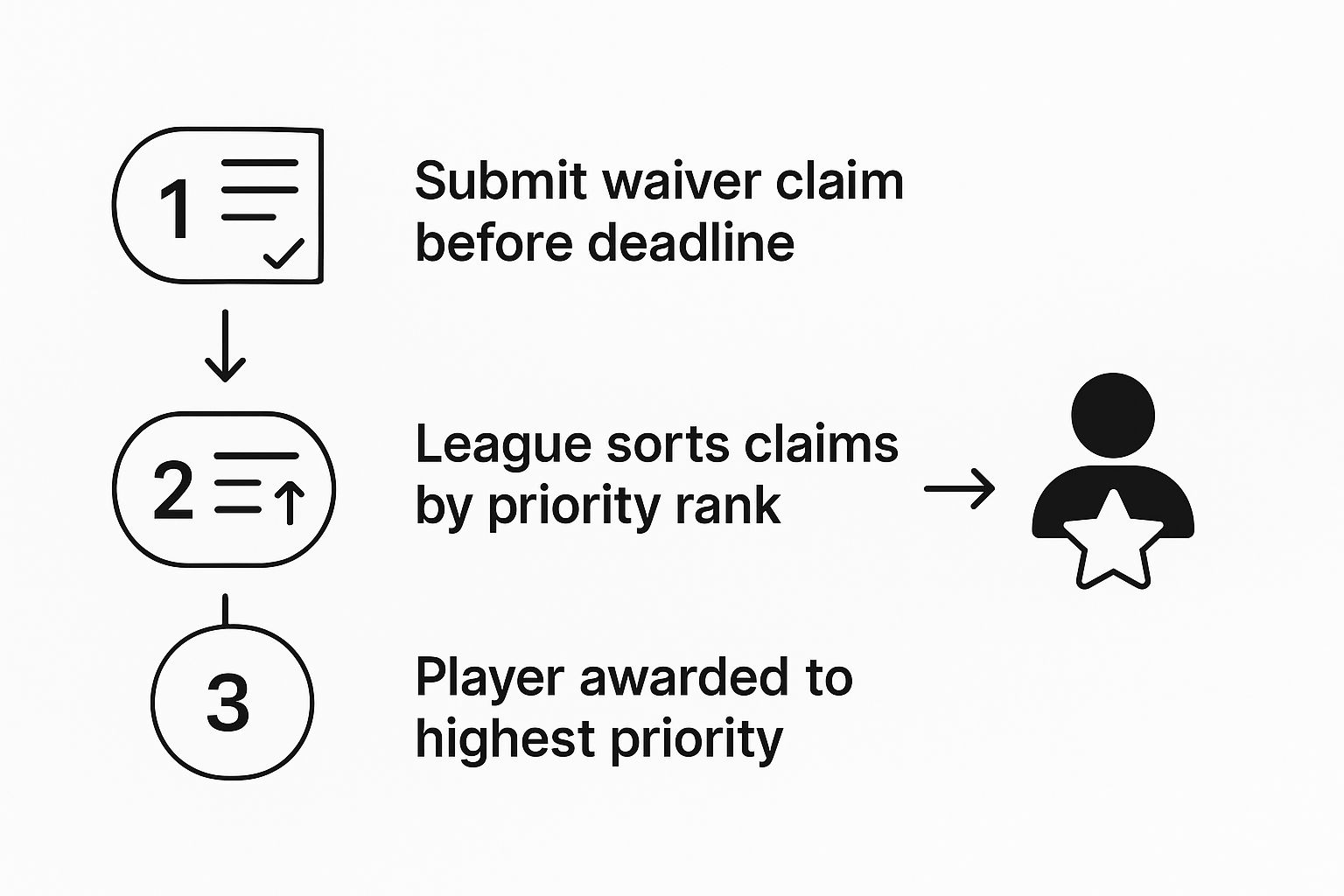
As you can see, the core steps are always the same. You put in a claim, the system sorts all the claims based on the rules, and a winner is declared.
Key Takeaway: In a rolling system, your priority is your currency. In a FAAB system, your budget is. Don't spend either without thinking about the long-term consequences for your team.
Most platforms process waiver claims overnight, usually somewhere between 3 a.m. and 5 a.m. ET. This keeps things fair for everyone in different time zones, ensuring nobody gets a head start. But always, always check your specific league settings to be sure.
How to Time Your Waiver Claims for Maximum Impact
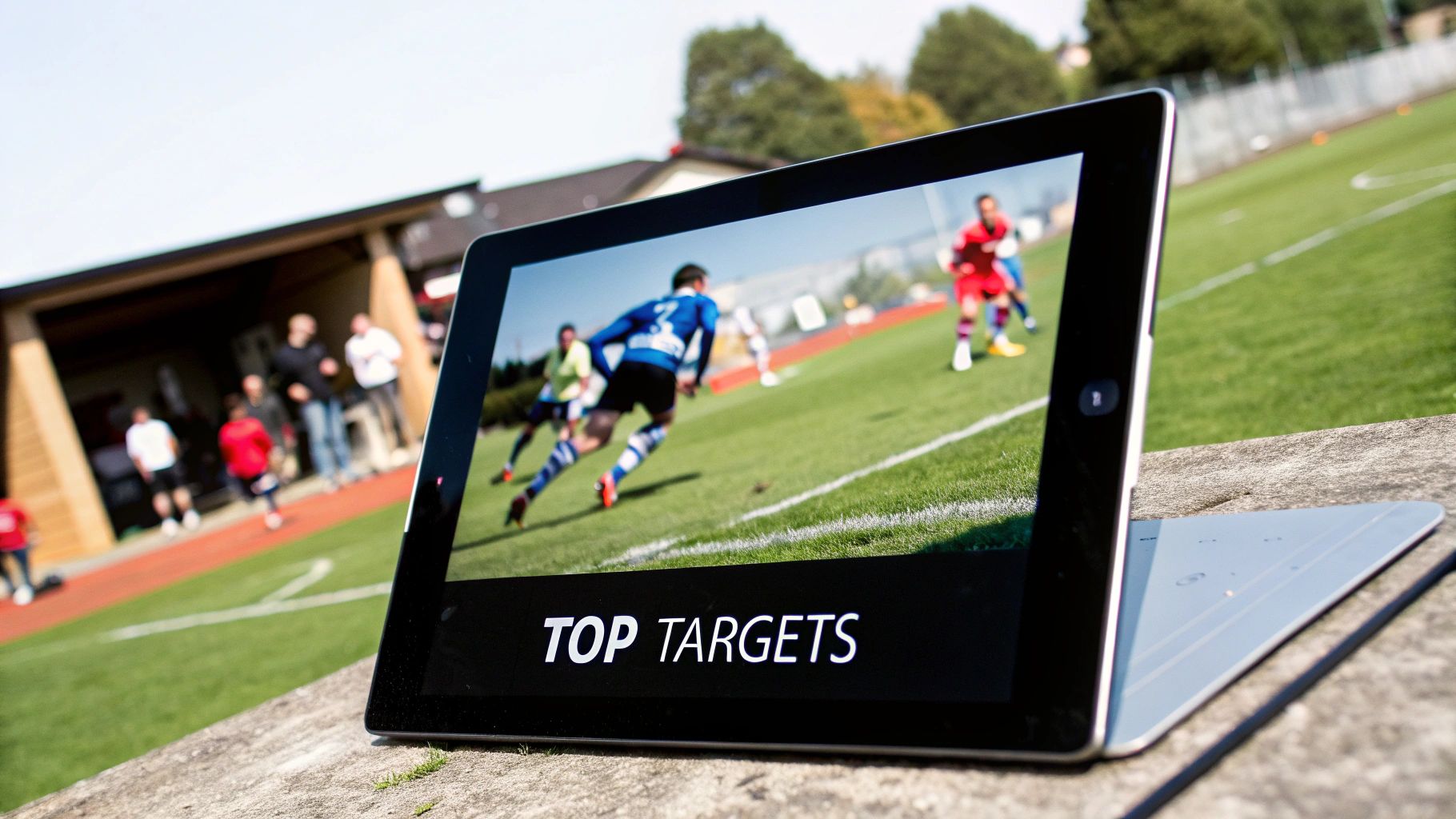
Grabbing a hot player off the waiver wire feels good. Grabbing them the week before they get hot? That’s how you win a fantasy championship.
It’s easy to fall into the trap of just reacting to last week’s top performers, but that’s a losing game. The real edge comes from being proactive—using a bit of foresight to snag a player just as their value is about to take off.
Effective timing means looking past the box score. Instead of chasing points that are already on the board, you need to be analyzing schedules, sniffing out roster changes, and spotting favourable matchups before anyone else does. It’s all about thinking one step ahead.
Master the Art of Streaming Players
One of the most powerful strategies in your timing arsenal is player streaming. This is the fine art of picking up a player for a short-term burst of games, then dropping them for another who has a similarly juicy schedule. It’s all about maximizing the number of games played by the guys at the end of your bench.
To pull this off, you need to look at the NHL schedule a week in advance. Zero in on teams playing on quieter nights like Mondays, Wednesdays, or Sundays. These are days when most of your studs are probably sitting, so a streamer can slide into an empty roster spot and quietly rack up points for you.
Also, keep an eye out for teams with a heavy weekly schedule. A player from a team with four games in a week simply has a much higher scoring ceiling than a similar player on a team with only two games. Schedule density was a huge factor for Canadian fantasy leagues during the 2024-25 season. Take Week 22 in March 2025, for instance—teams like Boston, Buffalo, Calgary, and Toronto all played four games, creating massive streaming opportunities.
With 28 out of 32 NHL teams having busy schedules on Thursdays and Saturdays, those became key days to maximize your games played. You can get more ideas on how to do this by digging into weekly fantasy hockey breakdowns.
Anticipate Roster and Lineup Changes
The best waiver wire GMs are part talent scout, part fortune teller. They don't just see what a player is doing right now; they predict what that player will be doing next week.
A proactive waiver claim is a calculated bet on future opportunity. You aren't buying the production that already happened; you are investing in the production that is about to happen.
Pay obsessive attention to team news and injury reports. When a top-line forward goes down, someone has to step up and fill that void.
- Spotting Promotions: Who's that second-liner most likely to get bumped up to play with the team’s superstars? Grab him.
- Power Play Opportunities: Notice a defenceman suddenly getting reps on the top power-play unit in practice? That’s your cue.
- Goaltender Injuries: The second a starting goalie gets injured, their backup becomes an immediate must-add in almost every league.
By getting ahead of these moves, you can claim a player before their role expands and their point totals explode. This is how you land game-changing assets for free, while your league mates are left chasing last week's news.
Identifying High-Value Players Before Your Rivals
Winning on the fantasy hockey waiver wire means becoming your league's best talent scout. It’s not about chasing the players who just had a huge week; it's about finding the players who are about to. Moving beyond basic stats like goals and assists is the key to unlocking true, sustainable value before your rivals even know who to look for.
The secret is to focus on opportunity. A player's talent is one thing, but their situation—their ice time, linemates, and role on the team—is what truly dictates their fantasy output. A decent player getting top-line minutes is often more valuable than a star buried on the third line.
This means you need to dig into the underlying metrics that signal a breakout is imminent. These are the tell-tale signs that a player's role is expanding, which almost always precedes a jump in production.
Look Beyond the Obvious Metrics
To consistently find hidden gems, you need a checklist of indicators that point to future success. Instead of just looking at points, start evaluating the factors that create points in the first place.
Here are the crucial stats to monitor:
- Total Ice Time (TOI): Is a player's average time on ice trending upward over the last few games? A significant jump, even by two or three minutes, is a massive indicator of a coach's growing trust.
- Power Play Deployment (PP%): Getting a spot on the top power-play unit is one of the biggest fantasy game-changers. A player moving from the second unit to the first can see their value skyrocket overnight.
- Shot Volume (SOG): Goals can be fluky, but shots are a sign of consistent offensive involvement. A player who starts shooting the puck more is creating their own luck and is often on the cusp of a scoring streak.
By focusing on these leading indicators, you can spot trends before they translate into fantasy points on the scoreboard. This approach lets you acquire high-potential players for free, right before they become the week's hottest commodity.
To help you get started, here's a quick look at the kind of things I'm always searching for on the waiver wire.
Key Indicators for Waiver Wire Targets
| Indicator | Why It Matters | Example |
|---|---|---|
| Increased Ice Time (TOI) | Shows a coach's growing trust and puts a player on the ice for more scoring chances. | A third-liner sees his average TOI jump from 12:00 to 15:30 over three games. |
| Promotion to PP1 | The single biggest boost to fantasy value, giving access to prime offensive zone starts. | A forward moves from the second power play unit to the top unit after a teammate's injury. |
| Top-Line Promotion | Skating alongside a team's elite players is a direct path to more points. | A young winger gets a chance to skate with the team's top two offensive stars. |
| Spike in Shot Volume | High shot totals signal offensive confidence and often lead to goal-scoring streaks. | A defenceman who averaged 1.5 shots per game suddenly puts up 4+ shots in back-to-back games. |
Keep these situations on your radar, and you'll consistently be a step ahead of your league mates.
Find Low-Rostered Players with High Upside
The most rewarding finds on the waiver wire are often the players no one is paying attention to. Targeting players with low ownership percentages but a clear path to a better role is a championship-winning strategy. Often, these are the players who benefit most from injuries to key teammates or from a mid-season line shuffle.
Successful waiver wire managers don't just find good players; they find good players in great situations. Your goal is to identify the opportunity before it becomes obvious to the rest of your league.
Recent history backs this up. In Canadian fantasy leagues during the 2024-25 season, players rostered in less than 5% of leagues frequently turned into high-impact additions. For instance, Dylan Holloway was only 2% rostered but became a top target due to a projected top-line role and his strong playoff performance. Similarly, a player like Pavel Dorofeyev, at 4% rostered, became a key pickup after demonstrating strong offensive contributions in limited action. Find more examples and learn about other top waiver wire pickups in this comprehensive NHL fantasy hockey analysis.
Keeping an eye on these overlooked players is essential. You can track their progress and be ready to pounce when the time is right. For more insights on who to target, you can check our constantly updated fantasy NHL rankings for 2025 to stay ahead of the curve.
Using the Waiver Wire to Win Your Fantasy Playoffs
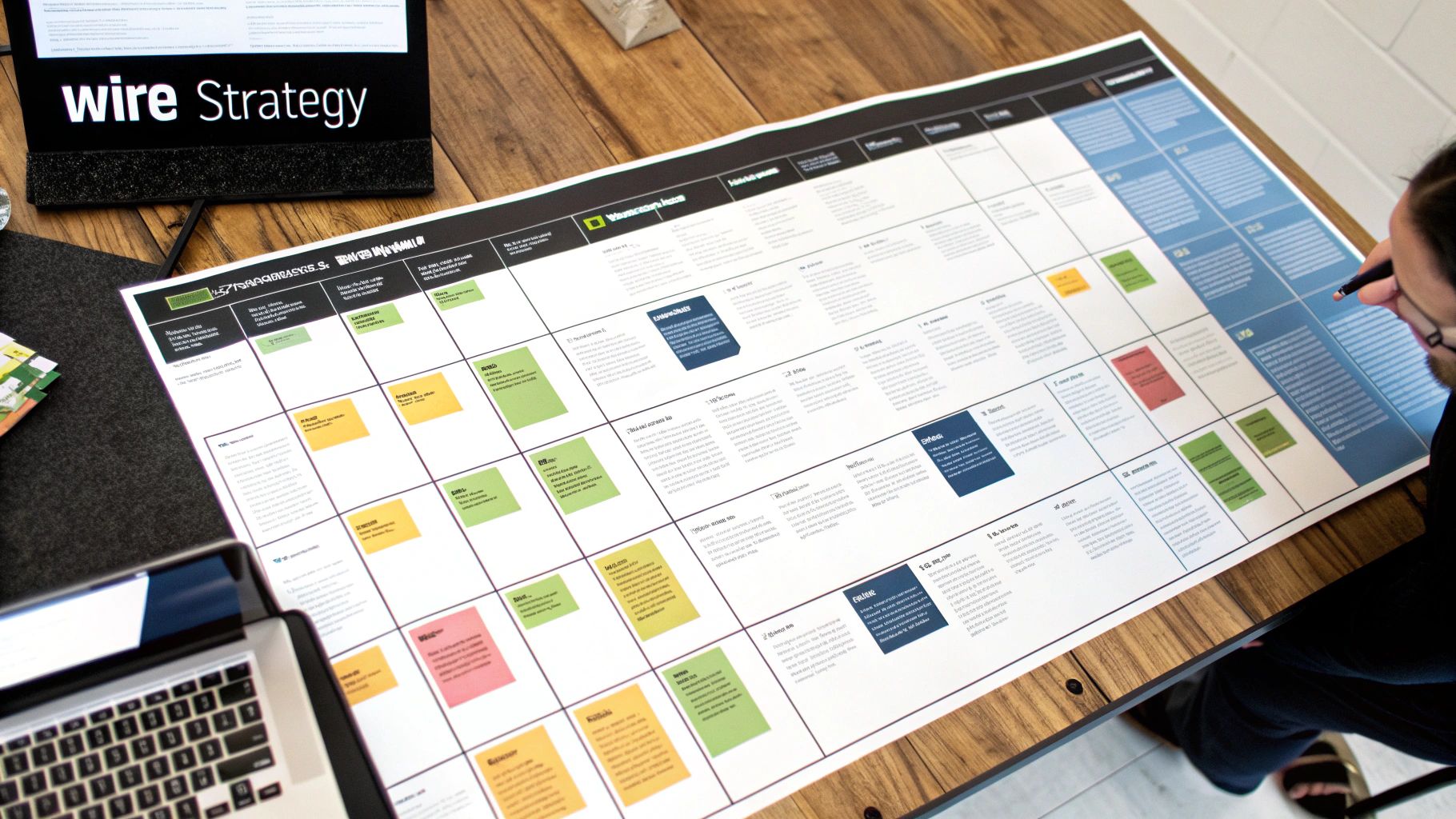
Once the fantasy hockey playoffs kick off, the waiver wire completely changes. It’s no longer just a place for gradual roster upgrades; it becomes the lifeline that can carry you to a championship. Every single move matters, and one smart pickup can be the difference between an early exit and lifting the trophy.
The patient, long-term strategy that got you here? It’s time to throw it out the window. In the do-or-die playoff format, your focus has to narrow down to one thing: winning this week. That means maximizing your games played and hunting for players with the best schedules for your current head-to-head matchup.
This is where managing your weekly adds becomes a crucial skill. You have a limited number of moves, and you have to make them count. Do you grab the hot hand right away, or save a transaction in case of a last-minute injury? One bad decision can leave you shorthanded when it matters most.
Navigating Late Season Chaos
The end of the NHL regular season is a chaotic time, creating unique challenges and huge opportunities. As real teams lock in their playoff spots, many will start resting their superstars to keep them fresh. This opens the door for depth players to suddenly get top-line minutes and power-play time.
A smart fantasy manager sees these lineup changes coming. The waiver wire isn't just about finding good players anymore—it's about finding decent players who are suddenly in a great situation, even if it's just for one week.
This is where your homework really pays off. Keep a close eye on teams whose playoff position is set in stone and, on the flip side, teams that are officially out of the race.
- Look for Depth Players on Top Teams: When a star like Connor McDavid gets a night off, a third-liner might suddenly find himself skating on the top power-play unit. These are the golden tickets.
- Identify Motivated Players on Bad Teams: Young players on non-playoff teams are often playing their hearts out for a roster spot next season. They have everything to prove and can rack up unexpected fantasy points.
Making the Championship Move
Your waiver wire approach in the playoffs needs to be surgical. Take the 2024-25 season, for example. In the critical Week 25, guys like Jonathan Huberdeau and Boone Jenner became hot waiver adds, partly because stars like Jack Hughes went down with injuries. Managers who only had four weekly adds had to make a tough call: use a move on a hot player now, or hold it for an emergency? You can find more analysis on this kind of late-season waiver strategy over on hockeconomics.substack.com.
Ultimately, it’s all about calculated, high-impact moves. Every waiver claim should be made to solve a specific problem in your current matchup, whether that’s getting more shots on goal, adding power-play points, or snagging a crucial goalie start. One perfectly timed pickup could be the final piece you need to lock up your fantasy title.
Common Waiver Wire Mistakes and How to Avoid Them
Even the sharpest fantasy hockey managers fall into the same old traps on the waiver wire. What separates the good from the great is learning to spot these pitfalls before you step in them. Get this right, and you’ll have a massive leg up on your league mates week after week.
One of the most common blunders is chasing last week's points. It’s so easy to see a guy pop off for a four-point night and rush to grab him. But that's a purely reactive move, looking in the rearview mirror. A single monster game is rarely a sign of things to come and almost never sustainable.
Instead of getting hypnotized by the box score, look at the why. Is the player’s ice time suddenly up? Did he get a promotion to the top power-play unit? A guy like Ross Colton, for example, became a hot commodity when injuries on the Avalanche vaulted him onto the top line with MacKinnon and Rantanen. That’s a real, sustainable opportunity—not just a one-night fluke.
Overreacting to Slumps and Trends
Another classic mistake is hitting the panic button and dropping a star player who’s hit a little cold spell. You drafted your studs for a reason; they're the bedrock of your team. Dropping a proven top-tier player after a few quiet games is a fast way to gift-wrap a championship-calibre asset for your rival. Slumps happen. It’s a long NHL season, so trust the track record.
The flip side of this is getting too attached to that waiver wire gem who was red-hot for you two weeks ago but has since gone cold. Don't cling to a player based on what they did for you in the past. You have to be ruthless here. If his role has changed or the production has completely dried up, it’s time to cut bait and find the next hot hand.
A winning waiver wire strategy isn’t about loyalty. It’s about constantly re-evaluating player roles and future opportunities to squeeze every last drop of potential out of your roster.
Mismanaging Your FAAB or Priority
Finally, burning through your resources will absolutely cripple your season. If you’re in a FAAB league, blowing a huge chunk of your budget on a non-essential player early on is a classic rookie move. You'll be left with empty pockets when a true game-changer inevitably hits the wire.
- Avoid Emotional Bidding: Don't get sucked into a bidding war just because you really want a guy. Figure out what he’s worth to your team and stick to that number.
- Guard Your Waiver Priority: In a rolling list system, using your #1 priority on a short-term streamer is a cardinal sin. Save that golden ticket for a player who can genuinely change the course of your season.
Fantasy Hockey Waiver Wire FAQ
The waiver wire is where leagues are won and lost, but it can feel a little confusing at first. Timing, priority, and how much to spend are all part of the game. Let's break down a few of the most common questions managers have.
When Is the Best Time to Make a Claim?
This is all about finding the sweet spot between acting fast and acting smart. While every league processes waivers at a slightly different time, the ideal window is usually after the last game of the week has finished but well before the waivers clear (typically very early Tuesday or Wednesday morning).
This gives you time to actually digest what happened. You can review player performances, check out the upcoming schedules, and react to any last-minute injury news. It's tempting to throw in a claim on Sunday afternoon, but a little patience lets you make a much more informed decision.
How Much FAAB Should I Spend Early On?
It's so easy to get excited and blow your budget in the first month. My advice? Be stingy with your Free Agent Acquisition Budget (FAAB) in those early weeks. One of the classic fantasy blunders is going all-in on a player after one unexpectedly huge week.
A good rule of thumb is to save the majority of your budget for the mid-season grind and the playoff push. That's when injuries and trades create real, game-changing opportunities, and you'll want the cash to pounce.
Should I Use a High Priority on a Goalie?
Only if you're absolutely certain they have a clear path to the starter's net on a decent team. Finding a reliable starting goalie on the wire is like finding a unicorn—it's incredibly rare. When that opportunity pops up, using a high waiver priority is often justified because it can stabilize your team for the long haul.
But be careful. Burning your #1 priority on a backup who's just getting a one-off "spot start" is a recipe for regret, unless you're in a truly desperate situation and have no other choice.
Gain the ultimate statistical advantage for your fantasy team with PuckNStick. Explore our in-depth player analytics and team performance tools today at https://www.pucknstick.com.
